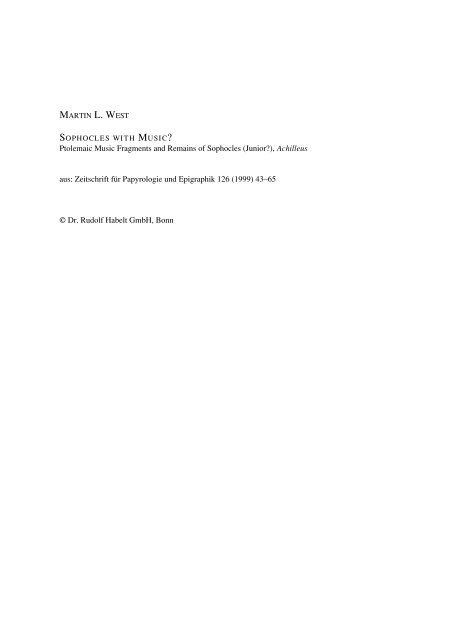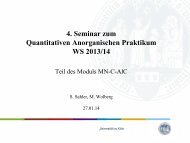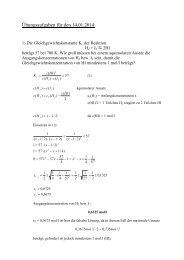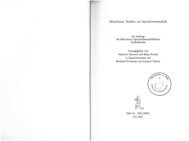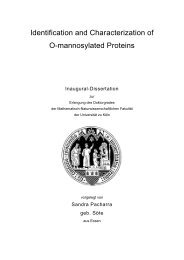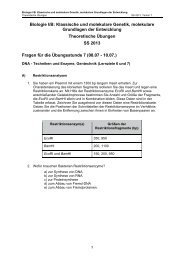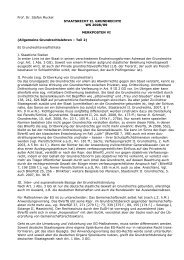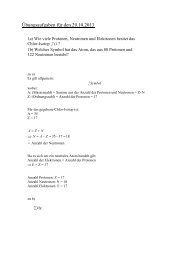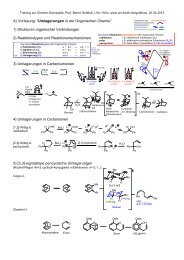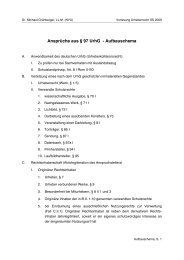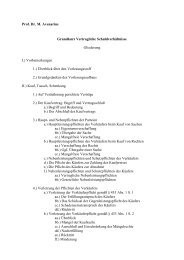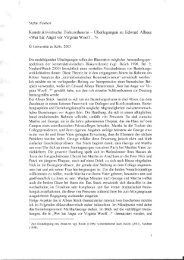Ptolemaic Music Fragments and Remains of Sophocles (Junior ...
Ptolemaic Music Fragments and Remains of Sophocles (Junior ...
Ptolemaic Music Fragments and Remains of Sophocles (Junior ...
You also want an ePaper? Increase the reach of your titles
YUMPU automatically turns print PDFs into web optimized ePapers that Google loves.
MARTIN L. WEST<br />
SOPHOCLES WITH MUSIC?<br />
<strong>Ptolemaic</strong> <strong>Music</strong> <strong>Fragments</strong> <strong>and</strong> <strong>Remains</strong> <strong>of</strong> <strong>Sophocles</strong> (<strong>Junior</strong>?), Achilleus<br />
aus: Zeitschrift für Papyrologie und Epigraphik 126 (1999) 43–65<br />
© Dr. Rudolf Habelt GmbH, Bonn
SOPHOCLES WITH MUSIC?<br />
<strong>Ptolemaic</strong> <strong>Music</strong> <strong>Fragments</strong> <strong>and</strong> <strong>Remains</strong> <strong>of</strong> <strong>Sophocles</strong> (<strong>Junior</strong>?), Achilleus<br />
(Pls. IX–XII)<br />
Among the unpublished papyri in the Ashmolean Museum are four folders (inv. 89B/29–33) containing<br />
a multitude <strong>of</strong> cartonnage scraps, partly crumpled or compacted, with literary text written along the<br />
fibres, in most cases accompanied by musical notation. They are published here (in so far as I can read<br />
them) by kind permission <strong>of</strong> the Egypt Exploration Society.<br />
It is not clear whether all the fragments come from the same roll or are all in the same h<strong>and</strong>, but they<br />
may be. They date from the third to second century BC. Their provenance is not recorded but is assumed<br />
to be somewhere in the Fayûm. Seven <strong>of</strong> the fragments in folders 31 <strong>and</strong> 33 have on the reverse (↓) side<br />
remains from a tragedy, identified by a subscription as ∆Acilleu;ª"º S<strong>of</strong>oklªevou"; there are also four<br />
fragments <strong>of</strong> the tragedy with nothing on the → side.<br />
Of the seven music fragments with tragedy on the other side, five look as if they are themselves<br />
tragic lyric, the other two being too small to give any clue. But <strong>of</strong> the music fragments with nothing on<br />
the other side, none is obviously tragic, <strong>and</strong> some are clearly not: C4 is <strong>of</strong> a distinctly <strong>and</strong> elaborately<br />
lyric character; in C13–15 we see some kind <strong>of</strong> erotic verse in the left-h<strong>and</strong> column, <strong>and</strong> in the right a<br />
citharodic sphragis with literary-critical comment, followed by the start <strong>of</strong> a new poem which seems to<br />
allude to a festival <strong>and</strong> torches. There is also a difference between the two groups in the character <strong>of</strong> the<br />
music. In the ‘tragic’ group, much the most frequent note is N (25 times), followed by M (7), U (7), P<br />
(5), T (4), <strong>and</strong> L (3), whereas in the other group the most frequent notes are L (73), P (72), U (56), M<br />
(47), <strong>and</strong> N trails behind with 20. The note Q, which implies a special form <strong>of</strong> tuning, as will be<br />
explained later, is not found in the ‘tragic’ group, but five times in the other.<br />
There is a possibility that the ‘tragic’ lyrics <strong>of</strong> the first group belong to the play from which iambic<br />
<strong>and</strong> anapaestic verses are preserved on the reverse <strong>of</strong> the same fragments. In P. Köln 241, which is also<br />
an Achilles tragedy from <strong>Ptolemaic</strong> cartonnage (but not in the same h<strong>and</strong> as ours), there st<strong>and</strong>s at line<br />
28, between two iambic episodes, the note a[lla ojpivsw corou' mªevlo", ‘more on the back: choral<br />
song’, suggesting that the text at least (if not the music) <strong>of</strong> the omitted ode had been supplied on the<br />
verso <strong>of</strong> the roll. 1 If the same practice was followed by the copyist <strong>of</strong> the play in the Ashmolean<br />
papyrus, we could treat the music fragments <strong>of</strong> the first group as additional fragments <strong>of</strong> that play,<br />
<strong>Sophocles</strong>’ Achilleus. This is obviously far from certain. The possibility, however, exists, <strong>and</strong> makes it<br />
inadvisable completely to separate discussion <strong>of</strong> the music fragments from discussion <strong>of</strong> the drama. I<br />
shall therefore first discuss the non-musical fragments <strong>of</strong> the drama (those on the ↓ side), then the music<br />
fragments associated with them, <strong>and</strong> then the rest <strong>of</strong> the music fragments.<br />
A. <strong>Fragments</strong> <strong>of</strong> <strong>Sophocles</strong>, Achilleus<br />
The play is identified by the subscription in fr. A12: ∆Acilleu;ª" ⁄ S≥o≥f≥ok≥l≥ªevou". The first omicron in the<br />
poet’s name may give more the impression <strong>of</strong> e; either it is (unlike the second) curiously squashed, or an<br />
accidental ink-stroke has created the appearance <strong>of</strong> a crossbar. But the other letters seem clear enough to<br />
leave little doubt about the name. It is uncommon for the name <strong>of</strong> the work to precede that <strong>of</strong> the author,<br />
but Dirk Obbink draws my attention to the subscriptions in P.Oxy. 3000 ERMHÇ ⁄ ERATOÇQENOªUÇ <strong>and</strong><br />
3715 FOINIÇÇAI ⁄ EU≥ªRºI≥PIDOU.<br />
The title ∆Acilleuv" is not attested for the famous <strong>Sophocles</strong>. It may have been an alternative or<br />
nonce title for a play better known under another name; the only suitable c<strong>and</strong>idate would seem to be<br />
1 See M. Gronewald’s note in Kölner Papyri 6 [1987], 20.<br />
43
44 M. L. West<br />
the Aithiopes or Memnon (probably already a play with two known titles). Or – perhaps likelier – this<br />
may be the younger <strong>Sophocles</strong>, the gr<strong>and</strong>son, who according to the Suda ‘produced forty dramas, or as<br />
others say, eleven’; they may have included a trilogy Telepheia (TrGF I, Did B 5.8), but none <strong>of</strong> their<br />
individual titles is recorded. There is nothing improbable about a play by him still being copied in Egypt<br />
around 200 BC.<br />
Plays entitled ∆Acilleuv" are attested for Aristarchus, Astydamas <strong>and</strong> Carcinus the younger,<br />
Cleophon, Diogenes <strong>of</strong> Sinope, Euaretus, <strong>and</strong> Iophon; there were also the ∆Acillevw" ejrastaiv <strong>of</strong><br />
<strong>Sophocles</strong> (thought to be satyric) <strong>and</strong> the ∆Acilleu;" Qersitoktovno" <strong>of</strong> Chaeremon.<br />
Discussion <strong>of</strong> the play’s content must start from the closing anapaests in A12. If I have understood<br />
rightly, they refer to certain persons’ souls flying <strong>of</strong>f to enjoy a happier existence elsewhere. Who are<br />
the dead individuals referred to? In a play entitled Achilleus, it is natural to suppose that Achilles<br />
himself is one <strong>of</strong> them. The other might be Memnon, whose fate was balanced against Achilles’ in<br />
(?pseudo-)Aeschylus’ Psychostasia. One might also think <strong>of</strong> Antilochus, whom Memnon had killed<br />
shortly before (Aethiopis, cf. Od. 4. 187 f.); for the association <strong>of</strong> Achilles <strong>and</strong> Antilochus in death cf.<br />
Proclus on the Aethiopis (line 196 Severyns), e[peita ∆Antivlocovn te qavptousi kai; to;n nekro;n tou'<br />
∆Acillevw" protivqentai. kai; Qevti" ajfikomevnh su;n Mouvsai" kai; tai'" ajdelfai'" qrhnei' to;n<br />
pai'da.<br />
There is one possible pointer to Memnon’s involvement in the play. If B5 belongs to it, the proposed<br />
reading there tavlan moi bal≥ªlhvn would imply lamentation by a chorus for their king, <strong>and</strong> since<br />
in both its two previously known occurrences (Aesch. Pers. 657; Soph. fr. 515) ballhvn is used by an<br />
Asiatic chorus <strong>of</strong> an Asiatic king, we must suppose that the oriental character <strong>of</strong> the title was generally<br />
felt. In a play which climaxed in Achilles’ death, an Asiatic chorus lamenting its king could hardly be<br />
other than an Ethiopian chorus lamenting Memnon. We know <strong>of</strong> a play by <strong>Sophocles</strong>, the Aithiopes,<br />
which had such a chorus, <strong>and</strong> it is generally assumed to have been identical with the Memnon mentioned<br />
in the Argument <strong>of</strong> the Ajax as one <strong>of</strong> <strong>Sophocles</strong>’ plays based on subject matter from the Trojan War.<br />
Very probably it dealt with Memnon’s death, <strong>and</strong> if so, his Ethiopian cohorts certainly lamented him.<br />
This may seem to agree nicely with our inference from B5. But a play called Memnon can hardly<br />
also have contained the death <strong>of</strong> Achilles, as if that were a subsidiary matter, <strong>and</strong> borne the alternative<br />
title Achilleus. So the fragments before us cannot, I believe, be identified with that play <strong>of</strong> <strong>Sophocles</strong>.<br />
We do not know <strong>of</strong> any other play <strong>of</strong> <strong>Sophocles</strong> that would accommodate them, <strong>and</strong> we seem to have a<br />
more or less complete list <strong>of</strong> all the plays <strong>of</strong> his that were known to Hellenistic scholars. I conclude,<br />
therefore, that the Achilleus was probably a work <strong>of</strong> the younger <strong>Sophocles</strong>. Just as his gr<strong>and</strong>father had<br />
taken the Memnon theme from Aeschylus, 2 so he (if indeed it had a place in the Achilleus) took it from<br />
his gr<strong>and</strong>father, but, with the later tragedian’s taste for including more event within the compass <strong>of</strong> a<br />
play, he made Memnon’s death (as in the Cyclic Aethiopis) the prelude to a greater catastrophe, the<br />
death <strong>of</strong> Achilles.<br />
It would not have been appropriate for an Ethiopian chorus to lament Achilles; but the playwright<br />
could easily overcome that problem by bringing on a secondary chorus <strong>of</strong> Nereids, led by Thetis. 3 She,<br />
or they, probably spoke the final words <strong>of</strong> consolation; such a positive affirmation about the destiny <strong>of</strong><br />
souls could only come from a divine source.<br />
An extra complication is raised by the apparent presence <strong>of</strong> Philoctetes in a dialogue scene (A10 ii<br />
4, 8). According to the Little Iliad <strong>and</strong> other accounts, he did not arrive at Troy until after Achilles’<br />
death, <strong>and</strong> indeed after the suicide <strong>of</strong> Ajax that followed the o{plwn krivsi". In some <strong>of</strong> Euripides’ later<br />
plays we see a tendency to open vistas towards events that were to follow after those covered in the<br />
2 There is no reason to doubt the authenticity <strong>of</strong> Aeschylus’ Memnon, even if (as I shall argue elsewhere) the<br />
Psychostasia was the work <strong>of</strong> his son Euphorion.<br />
3 A Nereid chorus had appeared on the stage in Aeschylus’ Nereides, which I think was the third play <strong>of</strong> the Achilles<br />
trilogy, not the second as generally supposed. There too, I believe, the Nereids lamented Achilles’ death.
<strong>Sophocles</strong> with <strong>Music</strong>? 45<br />
drama; compare also the interpolated ending <strong>of</strong> Aeschylus’ Septem, which prepares the ground for the<br />
Antigone story. Perhaps our <strong>Sophocles</strong>, in a similar spirit, brought Philoctetes into view before the end<br />
<strong>of</strong> his Achilleus in order to foreshadow the eventual Greek success in the war. Admittedly it is hard to<br />
imagine how this could have been done without great awkwardness.<br />
Here are the fragments.<br />
A1 (31 fr. b). A piece from the top right-h<strong>and</strong> portion <strong>of</strong> a column. The first line reads ºn≥ç≥pat≥ ≥ ≥l≥abein:<br />
<strong>of</strong> the next six lines there are only illegible faded traces, then in successive lines ºa≥noç ª, ºk≥l≥ª, º ≥ ≥ª<br />
A2 (31 fr. v). A small scrap, illegible.<br />
A3 (33 fr. a)<br />
. . .<br />
ºt≥ ≥ç≥ª<br />
ºi≥n ≥ª<br />
ºa≥rw≥ª<br />
º ≥wt≥ª<br />
5 º ≥axª<br />
ºi≥ll≥ª<br />
º ≥ ≥ª<br />
ºf≥a≥ª<br />
ºag≥a≥ç≥ ≥ª<br />
10 º ≥a≥ika≥l≥ª<br />
º ≥ ≥m≥al≥ ≥ª<br />
ºm≥a≥k≥a≥ir≥ai≥ª<br />
º ≥e≥cqu≥on≥t≥ª<br />
ºo≥i≥n≥o≥paq≥e≥ ≥i≥ª<br />
15 º ≥t≥u≥y≥ai≥ai≥ª<br />
º rubbed ª<br />
º ≥ ≥ ≥ ≥ ≥e ≥ç≥ep≥aª<br />
º ≥ ≥pa≥paipapaª<br />
º ≥ ≥w≥ne≥ktoç ≥ª<br />
20 º ≥ ≥a≥r≥i≥nai≥g≥en≥ª<br />
foot<br />
6 ∆Acºillª? 12 i≥ª: or n≥ª, m≥ª mavkaira(i)? Cf. A12.10 14 kºoinopaqevs≥i? 15 Perhaps e[ ≥tuy∆, aijai', cf. 18 papai'<br />
papaªi' 19 ejktov", ejk tovsw≥ªn? 20 a≥: or d, l ai≥g≥: or ag≥, making possible i{na genª.<br />
A4 (33 fr. b)<br />
. . .<br />
a≥p≥o≥t≥r≥ ≥ª<br />
n≥a≥uçço≥l≥ª<br />
m≥h≥l≥i≥n≥ ≥ª<br />
allat≥a≥p≥≥ª<br />
5 ºfe≥rnhç≥i≥l≥ª<br />
ºh≥çodu≥ç≥o≥m≥ª<br />
º ≥i≥b≥l≥e≥p≥ ≥ª<br />
. . .
46 M. L. West<br />
If it were not for line 5, we might take these lines to be trochaic tetrameters 6 Above h≥ç≥ is written a correction t≥e≥ If these<br />
are combinable to make two syllables, we can then consider ∆Oduss-. But there are other possibilities such as oJ dusovmilo".<br />
A5 (33 fr. c)<br />
. . .<br />
≥ ≥ ≥ ≥º ≥ ≥t≥e≥ª<br />
d≥ª ≥ºl≥e≥ ≥ ≥ ≥ª<br />
ei≥p≥h≥p≥ ≥ ≥ ≥ª<br />
e≥t≥a≥l≥ ≥ ≥ª<br />
5 p≥o≥ço≥ ≥ª<br />
. . .<br />
Questions <strong>and</strong> answers? (3 ei[p∆, 5 povso-; but t≥oço≥ also possible).<br />
A6 (33 fr. d)<br />
2 w\ m≥h'≥ter≥<br />
or w\ p≥av≥ter≥<br />
is not excluded.<br />
A7 (33 fr. e). Parts <strong>of</strong> two columns.<br />
. . .<br />
ºa≥ª<br />
w≥ ≥e≥r≥te ≥ª<br />
da≥ ≥ ≥ ≥ ≥ª<br />
• a≥l≥ª<br />
. . .<br />
. . .<br />
ºelª<br />
º ≥ ≥ ≥ ≥i≥o≥içepin≥ ≥i≥o≥iç ≥ ≥ª<br />
ºb ≥u≥toie≥n≥a≥uçia p≥eraª<br />
º ≥n≥a≥trapeiç etal≥ª<br />
. . .<br />
i 4 Probably ajnatrapeiv" ii 3 e.g. pevrªaine, cf. Eur. Med. 701, I.T. 781, Ion 362, 1348, Or. 1118; Trag. adesp. 631a.23<br />
4 e[t∆ a[lªl–?<br />
A8 (33 fr. f)<br />
. . .<br />
º ≥ª<br />
º aeiª<br />
º at≥e≥inª<br />
ºa≥p≥ ≥ ≥q≥u≥ª<br />
. . .<br />
2–3 A curious-looking layout. There may be letters lost before those printed, but I see no traces.<br />
The following fragments have nothing on the → side.
<strong>Sophocles</strong> with <strong>Music</strong>? 47<br />
A9 (33 fr. g). Possibly to be placed at the top <strong>of</strong> the next fragment, so that 9.4 i≥d≥e ≥ª = 10 ii 1.<br />
. . .<br />
≥ ≥ ≥ ≥ª<br />
<strong>and</strong>ro≥ª<br />
hkwnª<br />
i≥d≥e ≥ª<br />
. . .<br />
4 Above <strong>and</strong> to left <strong>of</strong> i≥, traces as <strong>of</strong> a rising diagonal.<br />
A10 (33 fr. h). Parts <strong>of</strong> two columns.<br />
. . .<br />
≥ª<br />
ºe≥t≥o≥ kª<br />
ºe e≥p≥i≥ç≥ª ≥ ≥ºm≥a≥n≥w≥d≥e≥ª<br />
º ≥ce≥to poian≥≥ª<br />
ºt≥o≥ç≥u≥i≥e≥t≥ ≥ª<br />
5 º ≥e kakaç≥gara≥n≥k≥a≥ª<br />
º yuchgarh≥q≥e≥l≥a≥≥ª<br />
º balleiçol ≥ ≥r≥o≥n≥ª<br />
ºa≥ç≥a≥i≥ poiantoçuion≥h≥q≥ ≥ ≥ª<br />
º ≥ª ºr≥a≥t≥a≥ª<br />
. . .<br />
ii 3 e.g. e[pisªceº mavn (cf. Denniston 331 f. for mavn with imperatives in drama), w\ deªino;n eijrhkw;" e[po" (cf. Soph. Phil.<br />
1402, Ar. Av. 174) 4 Apparently Poivanto" uiJev 5 kaka;" ga;r a]n kaªkoiv ge -oien tuvca" vel sim.? 6 yuch; ga;r<br />
h[qel∆, ajªlla;? 7 bavll∆ eij" o[le≥q≥r≥o≥n≥ seems likely 8 Poivanto" uiJovn.<br />
A11 (33 fr. j) Detached from under-layer <strong>of</strong> A12.<br />
. . .<br />
ºt≥ ≥ª<br />
ºtrat≥a≥u≥ª<br />
ºd≥e≥u≥ç≥e≥ª<br />
ºana≥m≥ª<br />
5 ºt≥o ≥ª<br />
. . .<br />
A12 (33 fr. k)<br />
. . .<br />
º ª<br />
ºt≥ ≥ ≥ª ºp≥i≥t≥a≥ª<br />
º ª º ≥ ≥o≥ ≥ª º ≥a≥ni≥ ≥ª<br />
º ≥ ª º ª º ª<br />
ºoçe ≥ª ºa≥ni≥h≥ª ≥ ≥º ≥op≥i≥ª<br />
5 ºu≥t≥ª ≥º ≥e≥am≥ª ≥ ≥º ≥ ≥e≥ç≥ª<br />
º ≥e≥ ≥ª ºu≥r≥ei ≥ª ≥ ≥ºc≥o≥ç≥ª<br />
ºd≥a≥m≥u≥rmidonw≥ª<br />
ºi≥a≥nt≥r≥opt≥omen≥a≥ª<br />
ºi≥n≥a≥ç≥a≥nakeçmat≥ª<br />
10 ºim≥ª ≥ºk≥ ≥i≥rai≥ ª
48 M. L. West<br />
º ª<br />
º ª<br />
º ACILLEU≥ª<br />
º Ç≥O≥F≥OK≥L≥ª<br />
. . .<br />
2 The first part <strong>of</strong> the line apparently blank 3 An apparently blank line apart from the obscure remains <strong>of</strong> one character,<br />
probably marking the beginning <strong>of</strong> the closing anapaests. It is not clear whether the anapaests were set out in dimeters, a<br />
practice which seems to have begun at about the time when this manuscript was written. In P. Hib. 1. 24(a), 25 <strong>and</strong> 2. 179 i 4<br />
ff. they are written as prose. However, in 7–9 anapaestic sequences are in fair vertical alignment, <strong>and</strong> in 10 the paroemiac<br />
ends where we should expect given dimeter layout 4 ajnihªr-? 5 e≥a: or q≥a 7 ºd≥a≥: or perhaps ºt≥o≥n≥ If ºd≥a≥, perhaps<br />
peºda; Murmidovnwªn; there are not many other possibilities, as the metre requires that ºda be part <strong>of</strong> a pyrrhich word 8 I<br />
suppose p≥ropt≥omen≥a≥ª , the participle <strong>of</strong> propevtomai , ‘flying forth’. u≥p≥opt-, which I had read, is palaeographically less<br />
good, though it would have been easier metrically, with e.g. uJpo; gaºi'an before it: propt - will require a monosyllable<br />
preceding it to satisfy the requirements <strong>of</strong> normal anapaestic technique; m≥a;n or p≥a'n is a possible reading. Forth or under,<br />
either kind <strong>of</strong> flying at the close <strong>of</strong> a tragedy seems most likely to have been predicated <strong>of</strong> the souls <strong>of</strong> dead persons;<br />
mªavºkairai in 10 lends colour to this idea. In 9 there was evidently a mention <strong>of</strong> healing, most naturally taken as a reference<br />
to death as a healer <strong>of</strong> all afflictions; see Pearson on Soph. fr. 698. Before the statement about souls we need a reference to<br />
burial: ‘their bodies we/you will proceed to bury, while their souls . . .’. For the programmatic statement about the buried<br />
bodies <strong>and</strong> freed souls cf. Eur. Erechtheus fr. 370.67 ff. There, as in the epitaph for the fallen at Potidaea, we find the famous<br />
antithesis ‘bodies to earth, souls to the sky’.<br />
An exempli gratia restoration <strong>of</strong> 7–10 might run:<br />
kai; swvmata me;n peºda; Murmidovnwªn<br />
kteriw': yucai;º m≥a;n proptovmenaªi<br />
plavka" aijqerºiv≥øn≥Øa≥"≥<br />
ajnavkesma tªuvch"<br />
qnhth'" e{xousºi mªavºkairai.<br />
Another possible reading <strong>of</strong> 8 may be º ≥a≥n≥ g≥a≥;r≥<br />
ojpu≥ovmen≥a≥ªi, which would set <strong>of</strong>f a quite different line <strong>of</strong> reasoning.<br />
B. The Tragic Lyrics<br />
I will preface this section with some general remarks on the music fragments in B–C. The notation is in<br />
principle the well-known vocal system. In reading it, it may be helpful to remember that a letter later in<br />
the alphabet represents a lower note; adjacent letters in succession (e.g. L M) normally represent notes a<br />
semitone apart (but other intervals cannot be calculated on this basis). Three features <strong>of</strong> the notation are<br />
characteristic <strong>of</strong> Hellenistic as against later texts:<br />
(i) When successive syllables are to be sung on the same note, it is normally written over the first<br />
only.<br />
(ii) When a long vowel or diphthong is to be divided between two notes, this is indicated by writing<br />
it double, not (as in the Roman period) by a double point <strong>and</strong>/or bracket in the notation: C15 i 3 ºe≥l≥eie≥i,<br />
ii 6 iww, 16.2 e≥k≥r≥o≥ibdo≥u≥o≥u≥menan≥, 18.1 ax≥eiei≥ , 25.1 dhh. It may be accidental that no example<br />
appears in the B group; the Orestes fragment shows that this mannerism is not alien to tragic song.<br />
(iii) Certain notes sometimes appear with a bar above them (M—, N—, once T—) or through them (U). This<br />
is paralleled only in P. Zeno 59533 (Pöhlmann, Denkmäler no. 35), where the forms N— <strong>and</strong> U appear.<br />
The phenomenon is discussed by Pöhlmann, pp. 111 f. His conclusion (following Gombosi) that the bar<br />
is the diseme sign can no longer be maintained, as in the new fragments the barred symbols appear<br />
above short syllables in several places, as well as above the second element <strong>of</strong> the divided long vowel in<br />
e≥k≥r≥o≥ibdo≥u≥o≥u≥menan≥. I have no new explanation to <strong>of</strong>fer, but make two observations which any<br />
hypothesis must take into account: firstly that the barring seems to be limited to the three or four notes<br />
mentioned, <strong>and</strong> secondly that whereas repeating notes are in principle written only once, so that we do<br />
not expect successions such as N N, we do find M M—, M— M, M M— M, N N—, N— N, implying that the bar<br />
signifies some real modification. It can hardly be a modification <strong>of</strong> pitch, since the alphabetic system<br />
provides sufficient other resources for denoting fine intervals. I suppose the bar to mean that the same<br />
note is sung, but in a different way, or with some difference in the instrumental accompaniment.
<strong>Sophocles</strong> with <strong>Music</strong>? 49<br />
The music is set in a baritone register, spanning no more than a diminished seventh, from U<br />
(approximately f) to B (approximately e' flat), <strong>and</strong> in fact it is for the most part confined within a<br />
narrower compass than that, as it seldom rises above L (b flat). All the fragments except C53 (see ad<br />
loc.) appear to be notated in the same key, in which the degrees <strong>of</strong> the basic scale are represented by the<br />
notes U P M L Q G. (The higher note B, which occurs once, should perhaps be treated not as a regular<br />
scale degree but as an ‘accidental’.) Except for the Q (which appears only in the C fragments) this series<br />
corresponds to a segment from two conjunct diatonic tetrachords from the Dorian or Phrygian systems;<br />
they could be described as Hypodorian Diezeugmenai + Hyperbolaiai, or as Phrygian Mesai + Synemmenai.<br />
The latter alternative has the advantage that it contains a Mese (M), which is supposed to be the<br />
cardinal point <strong>of</strong> a tuning. However, M is not the most frequent note in our fragments, <strong>and</strong> does not<br />
st<strong>and</strong> out as being <strong>of</strong> especial importance in the melodies. We should attempt to evaluate the music on<br />
its own terms, without assuming that the choice <strong>of</strong> notation-key is more than arbitrary. From the musical<br />
point <strong>of</strong> view the effective tetrachord seems to be U P M L, cutting across the theoretical semitone–tone–<br />
tone tetrachords <strong>of</strong> the Phrygian scale system <strong>and</strong> showing a tone–tone–semitone structure.<br />
Above L, the anomalous Q takes the place <strong>of</strong> an expected H, at least in the C fragments. Once again<br />
the Zeno papyrus provides a precise parallel: there too the lowest note is U, <strong>and</strong> the scale runs U P M L Q<br />
(no higher note appears in the fragment). The Q in place <strong>of</strong> H must represent a slightly flattened note,<br />
giving an interval above L <strong>of</strong> something like three-quarters <strong>of</strong> a tone instead <strong>of</strong> a full tone. 4 The interval<br />
Q G is then 1 1/4 tones. This arrangement <strong>of</strong> intervals in the tetrachord M–G, 1/2 + 3/4 + 1 1/4 tones, is one<br />
recognized by Aristoxenus, who calls it ‘s<strong>of</strong>t diatonic’ (diavtono" malakov", Harm. 2.51), <strong>and</strong> it<br />
resembles what Ptolemy calls ‘tense chromatic’ (crw'ma suvntonon, Harm. 1.15 <strong>and</strong> 2.14, pp. 35.7 <strong>and</strong><br />
72.4 Düring: ratios 22:21, 12:11, 7:6, i.e. 81 + 150 + 267 cents). The combination <strong>of</strong> this in the upper<br />
tetrachord with the regular ‘tense’ diatonic in the lower seems to be prohibited by Aristoxenus, but it is<br />
recognized by Ptolemy: it is incorporated in the kithara tuning that he calls trovpoi <strong>and</strong> the lyra tuning<br />
that he calls malqakhv. 5<br />
There is a certain amount <strong>of</strong> use <strong>of</strong> non-scalar notes, especially T <strong>and</strong> N, which must represent the<br />
semitones between U <strong>and</strong> P <strong>and</strong> P <strong>and</strong> M respectively, but occasionally also K (in group B) or I (in group<br />
C) for a note between L <strong>and</strong> Q, <strong>and</strong> D for one between Q <strong>and</strong> G.<br />
The accompanying diagram shows the notes in their places on a modern stave.<br />
Although we cannot follow any melodic line very far – the longest uninterrupted note-sequence is <strong>of</strong><br />
thirteen notes – some observations may be made. Melodic intervals seldom exceed a major third: rising<br />
fourths appears in C1, 6, 15, 45, <strong>and</strong> 53, rising <strong>and</strong> falling fifths in C43, rising sixths in C28 <strong>and</strong> 44<br />
(diminished), <strong>and</strong> a falling sixth in C45. There is a tendency to oscillate between two notes separated by<br />
a semitone (C13, 15, 16, 44), a tone (B3, C13, 14, 55), a minor third (B1, C19, 27, 38, 41, 42), a major<br />
third (B3), a flattened fourth (C4), or a fifth (C43). Once we find the four notes <strong>of</strong> the effective tetrachord<br />
in descending sequence (C14: L M— P U, if M— may be treated as M), but otherwise we do not find<br />
even three successive scale degrees together. More typical is a ‘pentatonic’ type <strong>of</strong> progression, in<br />
which one <strong>of</strong> the inner notes <strong>of</strong> the tetrachord is passed over, as in C1 L M U; 2, 13, 19, 48 L P U; 19 <strong>and</strong><br />
46 U P L; in C15 cyclically U L P U L P U, <strong>and</strong> again after the coronis P L U P L U … U P L … L P U L P U.<br />
4 Not a semitone, because I <strong>and</strong> K also appear as ‘accidentals’ between L <strong>and</strong> Q. In the Zeno papyrus the sequence Q I<br />
K must represent successive quarter-tones, trisecting the 3 /4-tone scalar interval. The transcription in my Ancient Greek<br />
<strong>Music</strong>, 196 <strong>and</strong> 287, requires correction.<br />
5 See Ancient Greek <strong>Music</strong>, 171 f.
50 M. L. West<br />
The ‘accidentals’ are mainly used to create semitone or minor third intervals that vary the basic<br />
structure <strong>of</strong> the tetrachord. As noted above, the exharmonic N is especially prominent in the B<br />
fragments. In B1 it alternates insistently with U (minor third), but appears also next to P (semitone); in<br />
B3 it alternates with L (minor third), <strong>and</strong> with the exharmonic T (tone, as it were f# g# in the key <strong>of</strong> F).<br />
In C6 again we find minor thirds (T M, U N U); so too in C13 <strong>and</strong> 16 (M T oscillating), 29, 38, 41 (N U N,<br />
resolving with a rising semitone to M); in C8 <strong>and</strong> 41 descending semitone slides (P T U [also in the Zeno<br />
papyrus], L M N); descending semitones also in C21 (T U), 28 (G D), 37 (P T), 40 (N P). The leap from U<br />
to D (diminished sixth) in C44 is exceptional. 6<br />
Not much can be said about the relationship between melody <strong>and</strong> accent, as the identification <strong>of</strong><br />
words is <strong>of</strong>ten uncertain. There is reasonable agreement in B1, so far as it goes, 7 <strong>and</strong> in C13 i 4; 14; 15<br />
ii 6(?); 42.2; on the other h<strong>and</strong> there appear to be clashes in C1 i 4; 4. 1; 6. 7; 13 ii 2; 15 i 3; 16.2; 43.2.<br />
A large measure <strong>of</strong> disagreement should be an indication <strong>of</strong> strophic composition. I have sometimes<br />
referred to the rise or fall <strong>of</strong> the melody as a criterion for choosing between different possibilities for<br />
accentuation or word division, but it is clearly not a very dependable one.<br />
Here now are the fragments <strong>of</strong> the ‘tragic’ group.<br />
B1 (31 fr. b: verso <strong>of</strong> A1). A piece <strong>of</strong> unmistakably tragic character. The insistence on the two notes N U<br />
<strong>and</strong> the interval <strong>of</strong> a minor third is remarkable.<br />
top<br />
ºU N U N— N N≥ ª<br />
ºn≥e iwimoi ee axionton≥e≥rat≥ª<br />
ºN≥ U N U N≥ ª<br />
ºo≥d≥e≥ iwpopoiwçd≥a≥ª<br />
º U N ª<br />
ºm≥anth≥ ≥ª<br />
º N≥ P≥ ª<br />
ºp≥oç≥ ≥ª<br />
º N≥ ª<br />
5 ºh≥paiç ª<br />
ºN N ª<br />
ºd≥e≥t≥ª<br />
. . .<br />
1–2 Word-spacing as shown. Typically tragic exclamations: duvsthºne (?), ijwv(i) moi, e] e{ … ijw; povpoi, sung as follows:<br />
So far as I know, the spelling ijwvi is not found elsewhere, though w[i moi is well attested. The letters e≥rat≥ are turned under.<br />
a[xion to; gevra" not excluded 2 Perhaps tºovde 3 e.g. ojloivºman, ejºmavn t∆ 5 pai'"? Thetis lamenting Achilles? A space<br />
after; line-end?<br />
6 Perhaps it resolved to G; cf. the sequence U G D in C28.<br />
7 ‘Agreement’ is shorth<strong>and</strong> for the code set out in Ancient Greek <strong>Music</strong>, 199.
B2 (31 fr. v: verso <strong>of</strong> A2)<br />
2 o[fewn?<br />
B3 (33 fr. a: verso <strong>of</strong> A3)<br />
<strong>Sophocles</strong> with <strong>Music</strong>? 51<br />
. . .<br />
ºp≥hin≥ª<br />
º M ª<br />
ºç≥<strong>of</strong>≥e≥w≥n≥ª<br />
º ≥ ª<br />
. . .<br />
. . .<br />
ºk≥ ≥ ≥ ≥g≥ ≥ª<br />
º N≥ ≥ ≥ ª<br />
ºt≥nei≥ça≥q≥ª<br />
º ≥ ª<br />
ºl≥u≥a≥ªº ≥ª<br />
º ≥ P≥ ª<br />
ºt≥a≥m≥ª<br />
º M≥ ª<br />
5 ºn≥e≥onturo≥n≥ª<br />
º N— N ª<br />
ºe≥iç≥hproçq≥a≥ª<br />
º M M— ª<br />
ºm≥aiwkale≥ai≥ª<br />
º N ª<br />
ºufroneiçoço≥ª<br />
º M T N Tª<br />
º ≥ ≥i≥r≥l≥aiidaap≥ ≥e≥ni≥ª<br />
º N— T M— ≥ ª<br />
10 ºchlatai≥dedai≥ ≥ ≥ª<br />
º UM U M≥ L ª<br />
ºe≥naiçç≥w≥naª ≥ºe≥ª<br />
º N L≥ N— ª<br />
ºk≥uke≥i≥hraton≥ª<br />
foot<br />
5 Cheese? Young cheese? I cannot find another likely epithet for cheese ending in -neon. But it may have been a verb, e.g.<br />
e[kºneon, ‘I/they grated’; cf. Il. 11.639 ejpi; d∆ ai[geion knh' turovn, where an ancient grammarian read kneve, though<br />
analogous forms <strong>of</strong> knh'n are not otherwise found: see JHS 118 (1998), 190 7 wjkalevai ? The word is attested only in<br />
Hesychius (neuter singular) 8 eºuj-, eºu\, oºuj, sºu;, polºu;, etc., then (-)fronei'", frovnei", -fron eij("), then o{soª, o}" oª, oJ<br />
soª, etc. 9 i≥: or u≥ l≥: or c≥… ∆Acaii?da cannot be read 10 troºchlavtai 11 aji?sswn 12 Perhaps ºk≥o≥ukt≥h.<br />
B4 (33 fr. b: verso <strong>of</strong> A4). This <strong>and</strong> the three following fragments all have dialogue on the ↓ side<br />
. . .<br />
ºd≥u≥ª º ≥ ≥ ≥ª<br />
º N— N— ≥ª<br />
ºd≥efuç≥iaª<br />
º N— N— ª<br />
º ≥e≥idena ≥ª
52 M. L. West<br />
º T— ≥ ≥ ª<br />
ºcruçe≥ak≥ª<br />
º ≥ ≥ ª<br />
5 ºtª<br />
. . .<br />
2 d∆ e[fu", -de fuv", (ej)fusiva? Cf. below on B7 3 The bar over each N is uncertain.<br />
B5 (33 fr. c: verso <strong>of</strong> A5)<br />
. . .<br />
º ≥ ª<br />
ºa≥i≥path≥r≥m≥e≥i≥ª<br />
º ≥ª º P≥ P≥ªº ≥ ª<br />
ºfu talanm≥oi≥ bal≥ª<br />
º ≥ M P L P ª<br />
º ≥ coreue≥d≥ ;r vª ≥ ≥<br />
º ≥ ≥ ª<br />
. . .<br />
1 path;r 2 e[ºfu? The interjection fu' ‘Poo’, used in the presence <strong>of</strong> stinks, smoke, etc., is unlikely to be appropriate; it is<br />
not to be confused with feu' tavlan moi ‘my poor …’ calls for a following noun; perhaps bal≥ªlhvn, a word used by Aeschylus’<br />
Persians (657) <strong>and</strong> <strong>Sophocles</strong>’ Idaean shepherds (fr. 515). (basileu' does not suit the traces.) tavlan moi ballhvn<br />
will make a dochmiac 3 The second rho added above the line. One thinks first <strong>of</strong> covreue, then perhaps dªovmwi corrected to<br />
drªovmwi. But the melodic pattern is strange if this is astrophic verse, with the higher note on -e <strong>and</strong> then a lower one again.<br />
So one might consider e.g. covreu∆ e{drªana. But reference to dancing seems strange in the apparent context <strong>of</strong> lament.<br />
B6 (33 fr. d: verso <strong>of</strong> A6)<br />
. . .<br />
º K≥P≥ ≥ ≥ ª<br />
ºe≥t≥e≥a≥d≥e≥ ≥ ≥ª<br />
. . .<br />
If K is rightly read, it is isolated among these fragments, which otherwise have I as the accidental between L <strong>and</strong> Q (the<br />
Zeno papyrus, to be sure, has both side by side); <strong>and</strong> the ditone interval to P is not a typical product <strong>of</strong> chromaticism in these<br />
pieces. We should entertain the possibility that this fragment comes from a passage notated in a different key from the rest<br />
(cf. below on C53): in chromatic Dorian, Hypoionian, or Aeolian, or diatonic Hyperdorian or Hypoaeolian, K P would be<br />
normal notes <strong>of</strong> the scale.<br />
B7 (33 fr. e: verso <strong>of</strong> A7)<br />
. . .<br />
ºt≥i≥mec≥eifruagmo ≥ ª<br />
º G≥ ª<br />
º ≥ ≥ª ≥º ≥ei ª<br />
º ª<br />
. . .<br />
1 e.g. a[rºti m∆ e[cei fruagmov", but I should have preferred periv me or ajmfiv me. The phrase suggests a scene like that in the<br />
parodos <strong>of</strong> Aeschylus’ Seven against Thebes (cf. 84, 123, 151–3; 245 kai; mh;n ajkouvw g∆ iJppikw'n fruagmavtwn); less<br />
likely to be relevant, I suppose, is Call. Hymn. 5.2 ta'n i{ppwn a[rti fruassomena'n ta'n iJera'n ejsavkousa. Cf. B3.10<br />
troºchlavtai, <strong>and</strong> perhaps B4.2 fusiaª (Il. 16.506 i{ppou" fusiovwnta"). Aeschylus’ Memnon was kwdwn<strong>of</strong>alarovpwlo"<br />
(Ar. Ran. 962).
B8 (33 fr. f: verso <strong>of</strong> A8)<br />
1 <strong>and</strong> 3 may be notation<br />
<strong>Sophocles</strong> with <strong>Music</strong>? 53<br />
. . .<br />
kª<br />
p≥e≥ ≥ª<br />
≥ ≥ª<br />
t≥ª<br />
. . .<br />
C. The Other <strong>Music</strong> <strong>Fragments</strong><br />
If the blank-backed C fragments come from the same roll as the tragedy-backed B set, a fair length <strong>of</strong> it<br />
must have been left empty on the ↓ side after the final column <strong>of</strong> the Achilleus. The scribe then wrote the<br />
C texts on the verso <strong>of</strong> this blank portion, which was the left-h<strong>and</strong> part <strong>of</strong> the reversed roll (as it was not<br />
inverted). He left a gap <strong>of</strong> at least a column’s width between the C <strong>and</strong> the B texts, since the last lines <strong>of</strong><br />
the play have nothing on the back. If the C texts do not come from the same roll as the tragedy, it is still<br />
the case that the copying <strong>of</strong> the B texts did not begin at the beginning <strong>of</strong> the roll, but a blank area<br />
preceded them. This fact may lend a little additional colour to the possibility that the B texts were<br />
suppletory to the Achilleus manuscript <strong>and</strong> belonged at different points along its length.<br />
There is no certainty that the C texts themselves all come from one roll, though it is to be<br />
remembered that they are all written along the fibres. In the absence <strong>of</strong> evidence to the contrary, we will<br />
take it as a working hypothesis that we are dealing with one music manuscript.<br />
As musical compositions tended to be restricted in length, we should expect such a manuscript to<br />
have contained a number <strong>of</strong> different items, <strong>and</strong> this is confirmed by the presence in two places <strong>of</strong> a<br />
paragraphos accompanied by a coronis. Most <strong>of</strong> the fragments are too exiguous to reveal anything about<br />
the nature <strong>of</strong> the texts. But we might expect them to be citharodes’ repertoire, either excerpts from<br />
tragedies or citharodic nomes or dithyrambs. As noted at the beginning <strong>of</strong> the article, some <strong>of</strong> them do<br />
show clear signs <strong>of</strong> a lyric character, <strong>and</strong> C13 + 15 appears to contain remains from the end <strong>of</strong> a<br />
citharodic poem with a literary-critical sphragis. Perhaps the poems were all the work <strong>of</strong> one author.<br />
C1 (29 fr. a, top layer + 31 fr. d, top layer). The fragment from folder 29 contains ends from one column<br />
<strong>and</strong> beginnings from the next, with upper margin; the one from folder 31 has middles from six lines,<br />
also with upper margin, <strong>and</strong> has every appearance <strong>of</strong> belonging to the right <strong>of</strong> the other. Both pieces are<br />
stuck on top <strong>of</strong> an under-layer (C2). The first two verses in col. i seem to lack musical notation; the rest<br />
have it, or at least are spaced to allow for it.<br />
29 fr. a 31 fr. d<br />
64444444744444448 6447448<br />
top top<br />
U L ≥ª º U ª<br />
ºarogkear baru≥ ≥ ≥ª ≥ ºo≥r≥ent≥e≥ª<br />
º ≥ ≥ ≥ ≥ª º ≥nmhpwç U ª º P≥ T≥ á ≥é L≥ ª<br />
º q≥rupto≥ª º ≥a≥m≥e≥lak≥ª<br />
º ≥ ≥ ≥ª ºq≥e≥ ≥ ≥n ª ºM L U≥ª<br />
ºL≥ M M—<br />
≥ ≥ ≥ a≥ ≥ ≥r≥aiª ºt≥ana≥i≥c≥ª<br />
ºn≥ida≥ç≥minati≥z≥ei P L ª º U≥ ≥ª<br />
º ≥ L M≥ ≥ ≥c≥ ≥h ≥ª º ≥ime≥l≥o≥d≥ª
54 M. L. West<br />
5 º ≥e≥iai≥ ≥ª ≥º ≥ ≥ T≥ ª º ≥ª º ª<br />
º P≥ª k≥ ≥ ≥t≥o≥m≥eª ºl≥l≥on≥ª<br />
º ≥ª ≥º ≥ º L P ª º ª<br />
ºe≥p≥ ≥ª ºd≥a≥neto≥ª<br />
º ≥ª . . .<br />
three lines stripped, then<br />
º P≥ª<br />
11 º ≥e≥çaite º ≥ ≥y≥ª<br />
. . .<br />
i 1 i.e. ºaro;n kevar 2 mhv pw" 4 min ajtivzei The note after M— may be P, T, U ii 1 e[qºoren, e[pºoren? 2 qrupto-<br />
ªmevºna m∆ ejlavkªtise or the like? 3 The placing <strong>of</strong> the notes suggests word-division after ºtan: aijcªm-, ai} cª?<br />
C2 (29 fr. a, under-layer + 31 fr. d, under-layer). Visible on the exposed portions:<br />
top<br />
º ≥k≥r≥ ≥ ≥ ≥k≥ex≥u≥p≥ai≥ª<br />
º ª<br />
º ≥a≥q≥izw≥n≥a≥mfoter≥ª<br />
º ª<br />
º ≥ ≥r≥oiol≥a≥wª<br />
º L≥ª<br />
º ≥raçe≥ l≥u≥eª<br />
º L P U≥ª<br />
5 º ≥ ≥ ≥ o≥ª<br />
Then three lines stripped, then traces <strong>of</strong> five more, the first having the letters ºe≥penn≥ ≥<br />
2 Probably ºk≥aqivzwn.<br />
C3 (29 fr. b). The fibres <strong>of</strong> this small fragment suggest that it may belong to the right <strong>of</strong> C2.3–5.<br />
. . .<br />
ºukoligo≥d≥r≥ª ≥º ≥ª<br />
ºM≥ U ª<br />
º ≥e≥pea ª<br />
º P≥ ª<br />
º ≥det≥o≥i≥d≥aim≥ª<br />
. . .<br />
1 oºujk ojligodrªaºnª- 3 t≥o≥i≥: or perhaps p≥i≥ daivmªwn?<br />
C4 (29 fr. c). Verse with notation over the first line only. This cannot (as in the case <strong>of</strong> the hexameter<br />
hymn from Epidaurus, ZPE 63 [1986], 39) represent a pattern to be followed throughout, because here<br />
the verses are <strong>of</strong> variable length, <strong>and</strong> their boundaries are not indicated in the manuscript. In modern<br />
transcription the note-sequence appears as
<strong>Sophocles</strong> with <strong>Music</strong>? 55<br />
top<br />
º ≥ ≥ L ª º P Q P U P≥<br />
≥ ≥ ≥º ≥a≥i≥ ≥a≥ªºq≥eia≥lew≥ie≥r≥hm≥ ≥tatai pª<br />
≥ ≥ºt≥enal ≥ªºoin≥ap≥oti≥plazetaiorm≥oiç ≥ª<br />
≥ ≥ ≥á é≥ºt≥anhr≥ªºy≥a≥l≥l≥o≥ç≥hre≥natr<strong>of</strong>o≥n<br />
≥ ≥á ≥éºz≥o≥nai≥d≥a≥nq≥rwpwnel≥ik≥it≥e≥ne≥a≥i<br />
5 ºn≥aclwronamf≥ ≥i≥n≥o≥i ª<br />
≥ ≥ ≥ºa≥u≥cena≥b≥a≥l≥ª ≥º ≥ª ≥ºkiççou≥kaieliççome AI ≥ª<br />
n≥a≥nçtafulan eriku≥m≥oçifo≥rbadwn â ª<br />
aigwntokoiçit≥e≥r≥pomenonkaiakratwi ª<br />
º ≥ ≥ª º ≥ ≥ ≥ ≥ ≥ª º ≥ ≥ ≥ ≥ ≥i≥ç≥<br />
. . .<br />
1–2 The letters preceding ªº in these lines are on a detached piece which someone has affixed here but which I am not sure<br />
belongs 1 Apparently ejrhm≥ov≥tatai<br />
(the melody favours this rather than dative -tavtai, though the higher note on -rh- is<br />
anomalous) 2 After l the tip <strong>of</strong> a descender below the line, e.g. i Perhaps oi[na; then potiplavzetai o{rmoi". ‘The vine<br />
straggles close with its festoons’? 3 Conceivably e.g. oJdovn t∆ ajnhvrªeºy∆, ‘<strong>and</strong> makes a ro<strong>of</strong> over the path’; ajnh'k≥ªe) also a<br />
possible reading. But I am baffled by what follows y≥: or f≥ l≥l≥: or d≥a≥ etc. ç≥: or q≥ e≥: or w, o a[llo" h\ren<br />
a[tr<strong>of</strong>on? 4 ºz≥: ºm≥ is another possibility; there may be others nai≥d≥: or perhaps nak e{likiv te neva–i 5 clwrovn ,<br />
perhaps agreeing with a noun lost before the break rather than with aujcevna, e.g. kat∆ ajmpelew'ºna; then just possibly ajmf∆<br />
a[ ≥g≥r≥oi⁄ªkonº aujcevna bavlªlºe≥ªiº, ‘garl<strong>and</strong>s the rustic round the neck with the young tendril <strong>of</strong> ivy <strong>and</strong> curling grape-clusters’.<br />
But it is difficult to make the n≥ at the end <strong>of</strong> 5 into a rho. I have also considered ajmf∆ eJ<br />
≥l≥ivnoi⁄ªsinº, but there is little space for<br />
el, <strong>and</strong> it is not easy to fit in the personal object presupposed by 8 terpovmenon 6–8 kissou' kai; eJlissom≥e⁄na'n<br />
stafula'n, then after a space <strong>of</strong> three letters ejrikuvmosi forbavdwn aijgw'n tovkoisi terpovmenon kai; ajkravtwi, ‘as he<br />
enjoys (the meat <strong>of</strong>) the fecund <strong>of</strong>fspring <strong>of</strong> grazing goats <strong>and</strong> the neat wine’; cf. Hes. Op. 592. ejrikuvmwn comes from<br />
Aesch. Ag. 119; here it appears to be transferred from the mother goats to their young. There is a paragraphos after 7 To<br />
the right <strong>of</strong> 7–8: AI[ over a paragraphos <strong>and</strong> coronis, presumably marking a new beginning in the following column. The<br />
AI[, if not a title such as (Timotheus’) Ai[a" ejmmanhv", might represent aijolistiv (abbreviated?); cf. P. Vindob. G 29825a/b<br />
recto 6 (Pöhlmann, Denkmäler no. 22), where a new section <strong>of</strong> the music is marked (in mid line) by a large chi with the word<br />
frugisti above it. But below this, blank papyrus where text would be expected.<br />
The content <strong>of</strong> the above piece may recall Antiphanes’ criticism <strong>of</strong> contemporary dithyrambists, whom he compares<br />
unfavourably with Philoxenus (fr. 207.7–9 K.–A.):<br />
oiJ nu'n de; kissovplekta kai; krhnai'a kai;<br />
ajnqesipovtata mevlea melevoi" ojnovmasi<br />
poiou'sin ejmplevkonte" ajllovtria mevlh.<br />
C5 (29 fr. m). Stuck on the back <strong>of</strong> the above piece.<br />
. . .<br />
º ≥ U ª<br />
ºl≥e≥inwçga≥ª<br />
º ≥ L Pª<br />
º ≥i≥terpno≥u≥p≥ª<br />
º ≥ª<br />
. . .<br />
1 kºleinw'" ga;ªr, baºlei'n wJ", etc. a≥ª: or l≥ª 2 terpnou'<br />
C6 (29 fr. d)
56 M. L. West<br />
. . .<br />
ºm≥eli≥çei ª º ≥ ≥ ≥ ≥ª<br />
º ≥ ≥ ≥ª º M U ª<br />
º ≥ª ºe≥e≥ ≥ ≥ ª<br />
about four lines stripped, then<br />
º ≥ª<br />
ºU≥ M U L ≥ M— ≥ M ≥ª<br />
7 ºu≥moiçegkaqed≥rai≥ç≥in≥e≥l≥agc≥aç≥o≥iw≥ ≥ª ≥ ≥ ≥º ≥ ≥k≥ª<br />
º P≥ T≥ M L M≥ L≥ U≥ ª<br />
ºmenonmelo≥ª<br />
º U N U L≥ª<br />
º ≥ ≥ª º ≥ ≥u≥t≥a≥ª<br />
. . .<br />
1 li≥: or lu≥ 7 Apparently ejn kaqevdraisin (or -ai" i{n∆), preceded by an adjective in agreement (e.g. hJduvmoi",<br />
eujwnuvmoi"), but I cannot make sense <strong>of</strong> what follows. Not ejlagcan-. The c could be k, sc. e{l∆ ajgkav" 8 ºmevnon mevloª"?<br />
(The melodic line would indicate a perfect rather than a present participle.)<br />
C7 (29 fr. e, top layer). Parts <strong>of</strong> seven lines <strong>of</strong> text, largely illegible. In line 3 I see ºn≥ ≥a≥r≥p≥ip≥te≥ne≥ª, in<br />
line 6 º ≥a≥i≥t≥ecn≥h≥ç≥hlª with the note M— above the c; 7 is completely illegible, but a note M can be made<br />
out.<br />
C8 (29 fr. e, under-layer)<br />
top<br />
ºP≥ M— ª<br />
º ≥a≥ ≥id>ikat≥ª<br />
º ≥ M I ª<br />
º ≥ ≥o≥i≥ç≥a≥d≥iw≥k≥ª<br />
º P M≥ ≥ª<br />
º ≥nte≥ ≥ ≥p≥e≥ ≥ª<br />
º P≥ T≥ U≥ª<br />
º ≥ ≥l≥e≥ç≥ ≥ ≥ ≥ª<br />
º ≥ ≥ ≥ M≥ª<br />
5 º ≥ ≥ ≥ ≥ ≥ ≥ ≥ª<br />
º L≥ M≥ ≥ª<br />
º ≥ ≥ ≥ ≥ ≥ ≥ª<br />
º ≥ª<br />
. . .<br />
C9 (29 fr. h). A scrap without notes.<br />
. . .<br />
º ≥ ≥ ≥i≥çekw≥ ≥ª<br />
º ≥c ≥ ≥p≥e≥ ≥ª º ≥ ≥f≥ª<br />
º ≥ ≥t≥e ≥ ≥ç≥a≥l≥m≥ª ºe≥cr≥hçfiloiçinª<br />
. . .<br />
3 e[crh" ‘you lent to your friends’? Or tºe≥c≥n≥hç
<strong>Sophocles</strong> with <strong>Music</strong>? 57<br />
C10 (29 fr. j). Narrow strip, about ten lines, only a few letters legible. The notes P T≥ are visible above<br />
the penultimate line <strong>and</strong> M— ≥ over the last.<br />
C11 (29 fr. k). Traces <strong>of</strong> two columns.<br />
. . .<br />
º ≥ ≥ ≥ ≥ª<br />
ºM≥ ≥ ≥ª<br />
ºn≥on e≥n≥ ≥ ≥ ≥ª<br />
º P . . .<br />
º ≥tan<br />
º<br />
. . .<br />
C12 (29 fr. l). Letters from two lines, blank space below, so line-ends or column foot.<br />
. . .<br />
ºe≥a≥g≥e ≥ª<br />
ºP≥ ª<br />
ºp≥o≥ntaª<br />
º ª<br />
º ª<br />
. . .<br />
C13 (30 fr. c + 29 fr. f). I have tentatively joined one fragment which contains ii 1–3, <strong>and</strong> the musical<br />
notes for the next line, with a wider strip containing parts <strong>of</strong> two columns. Above the third t <strong>and</strong> the p<br />
<strong>of</strong> line 4 are spots <strong>of</strong> ink on the upper edge <strong>of</strong> this latter fragment which precisely fit the tails <strong>of</strong> the first<br />
two T notes, <strong>and</strong> this (together with the thematic link u{mnon . . . a[(i)detai) is the basis for the join,<br />
which is not supported by any physical details <strong>of</strong> the front or back <strong>of</strong> the fragments <strong>and</strong> should therefore<br />
be treated with reserve.<br />
. . .<br />
º ≥ ≥ª<br />
ºL≥ P≥ L≥ M≥ ≥ L≥ P U P U ª<br />
º ≥e≥i≥e≥numnonk≥a≥t≥aq≥eion a≥q≥lio≥ª<br />
º U P U ª<br />
ºe≥u≥t≥e≥ ≥ ≥ ≥ ≥ ≥ ≥ ≥ ≥ ≥ ≥ ≥ ≥ ≥ ≥ ≥ ≥ ≥ ≥ ≥ª<br />
º T≥ M T≥ M≥ T M ª<br />
ºMLPL P tai≥l≥ª ≥ºl≥aitiçadetaie≥r≥p≥e≥ ≥ ≥eine≥iª º ≥a≥cen≥ ª<br />
ºp≥iep≥omhn L≥ Q M L≥ ª<br />
5 º ≥ ≥ ≥ ≥ ≥ ≥m≥ ≥ ≥ ≥m≥m≥oi≥ç≥e≥pik≥a≥ ≥ ≥ ≥ ≥ ≥ª<br />
. . .<br />
i 4 ejºpiepovmhn poetic for ejfep-? Cf. A.R. 2.18 ejpievyomai, [Opp.] Cyn. 3.272 ejpievspomai ii 2 I think these verses stood<br />
not far from the poem-end marked in 15 ii 4, <strong>and</strong> belonged to a citharodic sphragis. Here perhaps a prayer for the gods’<br />
favour, qeoi; caºr≥ei'en. The dotted letters in k≥a≥t≥aq≥eion are very uncertain. Then a space before a≥q≥lio≥ª (the last letter might<br />
be e≥ª), which perhaps introduces a polemical section 3 Or ç≥u≥g≥e≥ 4 Perhaps a[ ≥ªlºl≥ai tiv" a[(i)detai?<br />
The melodic sequences in i 4 <strong>and</strong> ii 2 may be transcribed as
58 M. L. West<br />
C14 (31 fr. g). The content suggests a possible location near 15 i: the piece looks good immediately<br />
above 15 i 1, but I cannot confirm a join.<br />
. . .<br />
º ≥ P≥ U ª ºP≥ª<br />
ºf≥ilhmat≥w≥n≥a≥p≥e≥ ≥ª<br />
º P U ª º P ª<br />
ºz≥h≥ ≥l≥a≥çall≥e≥m≥anekat≥ª<br />
º L M— ≥ P≥ U P ª<br />
º ≥ª<br />
. . .<br />
1 filhmavtwn ajpe- or ajp∆ ej- 2 I cannot rule out Zh'n∆ a[as∆ Then apparently ajll∆ ejma;n (or ejma'n, with e{kati?)<br />
C15 (30 fr. a). Parts <strong>of</strong> two columns. The piece resembles in appearance the latter part <strong>of</strong> C13, <strong>and</strong> I<br />
suspect that it (with C14) stood fairly close below it.<br />
. . .<br />
º ≥ ≥eokupridoç≥e≥k≥da u≥p≥ ≥ ≥ª<br />
º U L P U L P U L≥ ≥ L≥ U P ª<br />
º ≥w≥n≥ ≥e≥d≥r≥omonepikroton t≥o≥l≥l≥h≥ropatag<strong>of</strong>≥u≥ª ≥ºi≥ª<br />
ºM— ≥ T M P U ª<br />
ºe≥l≥eie≥ikaneime≥r≥wti ≥ ≥ ≥ ≥ ≥ ≥ ≥ ≥ ≥ ≥ ≥ ≥ª<br />
º G P≥ ª º ≥ ≥ ª<br />
º a≥ h≥r≥ª ≥ ≥ ≥º ≥ ≥ ≥a≥p≥o≥ ≥i≥d≥e≥t≥i≥polut ≥ ≥ª<br />
ºU≥ P â P≥ L≥ U P L U≥ P≥ L≥ M≥—<br />
P≥ ≥ ≥ ≥ª<br />
5 º ≥noçe≥iç≥ t≥ ≥ ≥nunodegw≥nu≥n≥d≥a≥i≥ ≥ ≥≥ª<br />
≥ ≥º ≥ ≥ ≥ ≥ ≥ ≥ ≥ ≥ª<br />
º ≥ L≥ P≥ Q≥ UP L M L≥ M≥ L P U L P U U ≥ª<br />
º ≥w≥ ≥ ≥≥e≥<br />
≥ ≥ e≥o≥r≥t≥h≥niwwl≥am≥ª ≥ºa≥ç≥a≥ne≥t≥ ≥mi≥d≥h≥çte≥ª ≥<br />
º ª<br />
. . .<br />
i 1 Probably a second-person verb (imperative or imperfect), then Kuvprido" ejkda- (ejk da-, ejk d∆ a-). If the suggested<br />
placing <strong>of</strong> C14 just above is correct, the notes M— ≥ P≥ U P probably stood over the syllables e(-o), Ku, pri, do 2 The<br />
melodic line implies the accentuation drovmon ejpivkroton, ‘a running-track trodden hard’ – perhaps a metaphor for the<br />
course <strong>of</strong> love which many have traversed, or possibly even with physical reference to a woman’s body 3 ff. are turned<br />
over onto the back <strong>of</strong> the fragment -eiei perhaps the dative ending <strong>of</strong> an adjective, doubled because divided between<br />
notes; the falling tone M— T (if M— approximates to M) would suit a circumflex accent, -ei', e.g. ojxubºelei'. Then prima facie<br />
kanei' m∆ e[rwti ‘will kill me with love’, though the descending tone M P conflicts with the accent. One might conjecture<br />
kaivei, but that was certainly not written 5 The P is placed over the e, implying -no" eij", -n o}" ei|", etc., rather than nosei'"<br />
6 Q: or perhaps E ii 2 I can only make sense <strong>of</strong> this as to;(n) lhropatag<strong>of</strong>uªsºivªan (vel sim.), i.e. a satirical compound <strong>of</strong><br />
the kind that Pratinas used in criticizing the modern dithyramb (PMG 708.11 to;n ojlesisialokavlamon lalobaruvopa<br />
parameloruqmobavtan; cf. 2 polupavtaga). The paragraphos <strong>and</strong> coronis after 4 mark the start <strong>of</strong> a new poem or extract<br />
5 Apparently nu'n o{d∆ ejgwv, nu'n … 6 ejorthvn: ijw; lampav", with the w doubled because divided between two notes (sc. P<br />
L, a rising minor third); cf. Eur. Phoen. 226 ijw; lavmpousa pevtra puro;" dikoruvfwn sevla" uJpe;r a[krwn bakcei'on
<strong>Sophocles</strong> with <strong>Music</strong>? 59<br />
Dionuvsou. There seem to be too many notes over lamªpºav", if the faint L≥ <strong>and</strong> M≥ are both real. Then perhaps a}n (sc. the pine<br />
torch) e[tam∆ ”Idh" tev≥ªmpesi<br />
Ida, whether the Cretan or the Phrygian mountain, would suggest a Corybantic scene.<br />
The melodic sequences in i 2–3 <strong>and</strong> ii 5–6 may be transcribed thus:<br />
C16 (30 fr. d). Parts <strong>of</strong> two columns.<br />
. . .<br />
º ≥ ≥ ≥ ≥a≥ç≥ ª<br />
º L P M— ≥ T M pª<br />
º ≥ ≥ ≥e≥k≥r≥o≥ibdo≥u≥o≥u≥menan≥ ª<br />
º— ≥ P≥ U≥ U≥ M≥ L≥ ≥ ç≥ª<br />
. . .<br />
i 2 Apparently ejkroibdoumevnan, with the second syllable doubled.<br />
C17 (30 fr. e). A scrap extending across two columns. The only legible letters are in col. i ºa≥c≥oçiteim≥e≥ª<br />
(tºavco" i[te i[te is just possible, but does not look convincing) <strong>and</strong> in col. ii d≥açte≥r≥a≥ ≥ ≥ ≥ª <strong>and</strong> in the<br />
next line a Z≥. If this was a note, a different tonos from the prevailing Phrygian is implied, e.g. Lydian or<br />
Aeolian.<br />
C18 (30 fr. g). Hyperphrygian.<br />
. . .<br />
º ≥ L P T≥ª<br />
ºn≥ax≥eiei≥á ≥éel≥eª<br />
º ≥ ≥ Q≥ ª<br />
ºa≥bda≥á ≥élabda ª<br />
º ≥ ≥ U≥ U≥ ª<br />
º ≥ª<br />
. . .<br />
1 i≥á ≥é: or n≥ If eiei, probably melodic doubling <strong>of</strong> ei; any accent will have been circumflex (descending tone) 2 Presumably<br />
lºavbda lavbda. Possible references: (1) Labda the mother <strong>of</strong> Cypselus (Hdt. 5.92; but why doubled?); (2) some word or<br />
name spelt out (cf. Eur. fr. 382, Achaeus TrGF 20 F 33, Agathon 39 F 4, Theodectas 72 F 6, Callias ap. Ath. 453c–4a); (3) a<br />
sexual allusion (cf. Ar. Eccl. 920 with Ussher’s note). There might be a connection with the erotic context <strong>of</strong> 15 i.
60 M. L. West<br />
C19 (30 fr. h)<br />
2 i≥p≥: or i≥t≥<br />
C20 (30 fr. j)<br />
. . .<br />
º ≥a≥ ≥t≥d≥ ≥h≥n≥ª º ≥ ≥ ≥ ≥ª<br />
º ≥ ≥ª º L≥ L≥ P≥ U≥ U≥ª<br />
º ≥ ≥ ≥l≥i≥p≥a≥padeç≥i≥ ≥ ≥ ≥ª<br />
º L U≥ P L≥ P≥ª<br />
ºt≥ ≥ ≥ ≥ ≥l≥e≥ ≥e≥p≥i≥ç≥t≥ ≥ ≥ª<br />
. . .<br />
. . .<br />
º ≥ª ≥ºa≥m≥o≥n≥new ≥ª<br />
º M M— ≥ L ª<br />
º ≥ç≥ax alaai an≥ª<br />
º ≥ P≥ª º ≥ ≥ª<br />
. . .<br />
2 ç≥: perhaps p≥ ajlaaiv, apparently, but a context for blind women is hard to imagine, <strong>and</strong> one may think <strong>of</strong> ajlaãlÃaiv.<br />
C21 (30 fr. k)<br />
. . .<br />
º ≥ª<br />
º N≥ ≥ ª<br />
ºenboa≥t≥eubo≥a ≥ ≥ ≥ ≥ç≥i≥u≥ ª<br />
º T≥ U ≥ ª<br />
ºta ≥ ≥ax≥u≥ª ≥ ≥ ≥º ≥ª ≥ºe≥t≥ ≥ ≥x ª<br />
. . .<br />
2 boa't∆ eu\? But after the second boa apparently a round letter ç≥: or e≥<br />
C22 (30 fr. l). A scrap with one line <strong>of</strong> text:<br />
. . .<br />
º N≥ ≥ ≥ ≥ª<br />
ºa≥ulaçouk≥e≥d≥a≥ ≥ª<br />
. . .<br />
On the back <strong>of</strong> the fragment is another, with no text surviving but the note-sequence L M L P.<br />
C23 (30 fr. m)<br />
. . .<br />
º P≥ ≥ª<br />
ºr≥o≥p≥oçiçwnaká ≥é ≥a≥ ≥ª<br />
º N≥ ª<br />
ºo≥eiçxeinona ≥ ≥ ≥t≥a≥ª<br />
º Q≥ M≥ ª ºP≥ ª º ≥ ª<br />
ºokruoentid≥e≥c≥a≥ª<br />
ºP≥ª º U≥ ª<br />
. . .
<strong>Sophocles</strong> with <strong>Music</strong>? 61<br />
1 Perhaps (oi\no") … pºrovposi" w]n a[kr≥at≥ªo" 2 -ovei" or eij" xei'non 3 was folded under, <strong>and</strong> it is possible that one or<br />
more lines has been lost from the turned edge, between 2 <strong>and</strong> 3 ojkruoventi.<br />
C24 (30 fr. q)<br />
. . .<br />
º ≥ ≥ ≥ª<br />
ºL M ª<br />
ºo≥i≥kre≥ª<br />
º U≥ ≥ª<br />
. . .<br />
C25, 26 (30 frr. s/t). Two scraps stuck back to back.<br />
. . . . . .<br />
º ≥ L≥M≥ U Lª º G≥ ª<br />
ºdhhkamnwmª º allato≥ ≥ª<br />
º P≥ ≥ L≥ ª . . .<br />
º ≥ ≥ ≥ ≥ª ≥ ≥º ≥ª ≥ºu≥ ≥d≥ ≥ ≥ ≥ ≥ª<br />
. . .<br />
s 1 -dh or dh; with melodic doubling, such as also occurs in the emotional erotic context <strong>of</strong> 15 i, with which this fragment<br />
may have a connection. Then kavmnw (not -wn with assimilation <strong>of</strong> the nu to a following labial, as the note-placing indicates<br />
that mª begins a new syllable).<br />
C27 (30 fr. u). Traces from two lines <strong>of</strong> text (no letter legible), <strong>and</strong> between them the note-series L≥ P L<br />
P≥ L P N.<br />
C28 (30 fr. v)<br />
. . .<br />
P U G D ª<br />
boule≥i≥eideª<br />
. . .<br />
boule≥u≥ei does not seem to have been written. If this is another melodic doubling, for boulei, the large rising interval U G (a<br />
sixth) might suggest oxytonesis <strong>and</strong> thus an adverb, ªajº⁄bouleiv or the like, rather than the verb-form bouvlei. But a division<br />
bouvlei: eij de; is also possible.<br />
C29 (30 fr. w)<br />
. . .<br />
ºa≥ çud≥ª<br />
º N U ≥ª<br />
ºn≥i≥p≥pa ≥l≥ª<br />
. . .<br />
C30–4. Five other scraps from folder 30 (f, n, o, p, r) with only a few letters apiece <strong>and</strong> no musical<br />
notes. One has an apparent mention <strong>of</strong> Orpheus: r 3 º ≥ ≥ ≥u≥p≥o≥r≥f≥e≥ª.<br />
C35 (31 fr. a). Five or six lines <strong>of</strong> text without notation, then (after a gap) a line with it, presumably the<br />
beginning <strong>of</strong> a new section or excerpt. This <strong>and</strong> the next fragment have a similar layout <strong>and</strong> appearance<br />
<strong>and</strong> may have stood at the same level in the same column, but I cannot match up the fibre patterns.
62 M. L. West<br />
≥ ≥<br />
5<br />
. . .<br />
º ≥ª<br />
ºu≥naikwg≥garo≥ª<br />
º ≥i≥ç≥e≥i≥d≥a≥ ≥ª<br />
ºe≥arçeno ≥ª<br />
ºt≥wnde≥ª<br />
º ≥kap≥ª<br />
.<br />
º Lª<br />
ºk≥e≥p≥ª<br />
. .<br />
2 gºunaikw'n ga;r, with the nu assimilated to the velar 4 a[rsen(o-) 6 This does not join up with fr. c 5 as kapnou'.<br />
C36 (31 fr. c). Five lines <strong>of</strong> text without notation, then four lines with it.<br />
. . .<br />
ºw≥iprig≥k≥ ≥ª<br />
º ≥en≥q≥e≥ ≥ ≥eaª<br />
º ≥ ≥ ≥ ≥r≥h≥p≥e≥p≥ª<br />
ºeq≥açpan≥ ≥ª<br />
5 ºp≥noude ≥ª<br />
º ≥ª<br />
º ≥n≥a≥ ≥ ≥ª<br />
º L M≥ª<br />
ºpontiw≥ª<br />
º P≥ ª<br />
º ≥e≥i≥na≥ª<br />
º ≥ ª<br />
º ≥ ≥ª<br />
. . .<br />
1 i.e. pri;n k ≥ª 4 mºevqa" pan-, -mºeqa span-?<br />
C37 (31 fr. e, top layer)<br />
C37 bis (31 fr. e, under-layer)<br />
. . .<br />
º ≥ ≥ª<br />
º P ª<br />
º ≥ ≥l≥eto≥ª<br />
ºP≥ª<br />
. . .<br />
. . .<br />
º ≥ ≥ ≥ ≥ ≥ª<br />
º ≥ ≥nat≥ ≥ª<br />
º abraded ª<br />
º ≥l≥ine≥ª<br />
º P ª<br />
ºame≥i≥ ≥ª<br />
º P ≥ª<br />
. . .
C38 (31 fr. f)<br />
<strong>Sophocles</strong> with <strong>Music</strong>? 63<br />
top<br />
º N N— ≥ U≥ N Uª<br />
º ≥ ≥ ≥e≥x≥a≥pao≥n≥ª<br />
. . .<br />
C39 (31 fr. h). Traces <strong>of</strong> about six lines, only a few letters legible. Visible notes in successive lines are<br />
P (twice) <strong>and</strong> perhaps T.<br />
C40 (31 fr. j)<br />
. . .<br />
ºm≥el≥lo≥ª<br />
º ≥ª ºL≥ª<br />
º ≥e≥p≥ª<br />
ºN P≥ ª<br />
º ≥l≥i≥p≥ª<br />
. . .<br />
C41 (31 fr. k). Parts <strong>of</strong> two columns. Line 3 with its notation is turned under. In view <strong>of</strong> the festive<br />
content <strong>of</strong> col. ii, one may conjecture that the piece stood somewhere below C15.<br />
. . .<br />
ºr≥a≥t≥o≥ NN NU N M≥ª<br />
º it≥w≥i≥t≥w≥kw≥m≥o≥ç≥ç≥ ≥ª<br />
ºy≥e≥i≥ ª º L M N≥ ª<br />
º eiçambaçintai ≥ª<br />
º P L P L≥ P≥ ª<br />
≥º ≥ ≥d≥ ≥ ≥ ≥ ≥ª ≥ ≥ ≥ ≥º ≥ ≥t≥ ≥ª<br />
. . .<br />
ii 1 Broken <strong>of</strong>f immediately above the notes, so that any N may have been N—. N N— N, for example, would avoid the written<br />
repetition <strong>of</strong> consecutive identical notes, which is avoided in these early texts i[tw i[tw kw'mo". i[tw i[tw has ritual<br />
connotations; see passages cited by Diggle on Eur. Phaethon 101 2 eij" a[mbasin, then perhaps tai; d≥ªe;.<br />
C42 (31 fr. l). Line-ends from the top <strong>of</strong> a column.<br />
top<br />
º L ª<br />
ºi≥dallo ª<br />
º M N— -ª<br />
ºo≥petran ª<br />
º ≥ N N— ª<br />
ºno≥i≥t≥w≥ª<br />
º L P L ª<br />
. . .<br />
1 d∆ a[llo 2 pevtran On the right edge, level with the notation, the tip <strong>of</strong> a horizontal; perhaps a paragraphos in the next<br />
column, as there are no remains at the same longitude in the two preceding lines.
64 M. L. West<br />
C43 (31 fr. m)<br />
. . .<br />
º ≥ ≥ ≥ ≥ ≥ ≥ ≥ ≥ ≥ ≥ ≥ª<br />
º ≥ P G P ª<br />
º ≥at≥iei deinon≥ª<br />
º ≥ M≥ M—<br />
≥ M≥ª<br />
ºc≥ª ≥º ≥i≥l≥ª<br />
. . .<br />
2 tivei, ajtivei? Then presumably deinovn, but if so, the melodic fall <strong>of</strong> a fifth goes against the accent.<br />
C44 (31 fr. n)<br />
C45 (31 fr. o)<br />
. . .<br />
L M L≥ª<br />
euh≥p≥ ≥e≥ª<br />
U D ª<br />
º ≥ª<br />
. . .<br />
. . .<br />
º ≥ ≥anª<br />
º M ≥ ≥ ª<br />
ºe≥n≥o≥llun≥aih≥d ≥ ≥ ≥ ≥ª<br />
º ≥ L G≥ U≥ L ≥ª<br />
º ≥ ≥ ≥ ≥t≥i≥ç≥p≥a≥ ≥ ≥ ≥ª<br />
. . .<br />
2 (ejn)olluvnai? 3 If interrogative tiv or tiv", the high note is appropriate; see Ancient Greek <strong>Music</strong>, 286 (the Iphigeneia<br />
papyrus), 314 (P. Mich. 2958. 2), 322 (P. Oxy. 3161 recto 3).<br />
C46 (31 fr. p). A scrap on which the only legible letters are ºa≥·da‚i≥t≥o≥ª (with au≥ written underneath<br />
·da‚) <strong>and</strong> for the next line the note-series N U P L≥.<br />
C47 (31 fr. q). A line-beginning u≥i≥ ≥taª <strong>and</strong> below it the notes U L N≥.<br />
C48 (31 fr. r). A mid-line fragment ºi≥ncali≥f≥ª (califªron-?) <strong>and</strong> below it the notes L P U.<br />
C49 (31 fr. s)<br />
2 w[ºdeinen, eu{ºdein ejn, etc.<br />
. . .<br />
º ≥ª<br />
º ≥ L M ª<br />
ºd≥einent≥e ≥ª<br />
. . .
C50 (31 fr. t)<br />
<strong>Sophocles</strong> with <strong>Music</strong>? 65<br />
. . .<br />
º ≥ ≥w≥n≥ª<br />
ºP≥ L ≥ª<br />
º ≥ ≥nteçe≥ª<br />
. . .<br />
C51 (31 fr. u). Traces <strong>of</strong> two lines, only a few letters legible; between them the notes L P L.<br />
C52 (32 fr. a). A few letters from the beginning <strong>of</strong> the first line in a column; above the second line the<br />
note N.<br />
C53 (32 fr. b). No text; consecutive notes (all uncertain) M R Q—. If these are correctly read, they suggest<br />
a different notation-key from the other fragments, namely Hypophrygian (Diezeugmenai–Hyperbolaiai)<br />
or Lydian (Mesai–Synemmenai). The barred theta is also significant in this regard, as in the other<br />
fragments the only barred notes are M N T U.<br />
C54 (32 fr. c)<br />
C55 (32 fr. d)<br />
. . .<br />
º ≥ote≥ ≥ ≥ª ≥ ≥ºp≥ª ≥º ≥ ≥ ≥ ≥ ≥ ≥ ≥ª<br />
ºm≥a≥q≥e≥ip≥ ≥ª ≥ ≥º ≥p≥eª ≥ ≥ ≥ºc≥ª<br />
. . .<br />
. . .<br />
º M≥ I ≥M≥ ª<br />
ºr≥p≥o≥e≥ç≥a≥á ≥ér≥m≥a ª<br />
º ≥ª º ≥ª<br />
. . .<br />
The notes on the right are faint, <strong>and</strong> appear to have no text below.<br />
C56 (32 fr. e)<br />
1 Probably pikrovªn<br />
. . .<br />
ºq≥eipik≥r≥o≥ª<br />
º ª<br />
º ≥ ≥ª<br />
stripped<br />
ºp≥ ≥ ≥ ≥u≥ª<br />
º ≥ ª<br />
º ≥c≥eim≥ª<br />
º L≥ ª<br />
5 ºt≥eçd≥ª<br />
. . .<br />
Folder 32 contains eight other illegible scraps.<br />
All Souls College, Oxford Martin L. West
Ashmolean Museum Inv. Nos. 89B/31 <strong>and</strong> 33, fragments A1+3+4+5+7+9+10+12;<br />
M. L. West, pp. 43–65<br />
TAFEL IX
TAFEL X<br />
Ashmolean Museum Inv. Nos. 89B/31 <strong>and</strong> 33, fragments B1+3+4+5+7; M. L. West, pp. 43–65
Ashmolean Museum Inv. Nos. 89B/29 <strong>and</strong> 30, fragments C13+15<br />
Ashmolean Museum Inv. Nos. 89B/30 <strong>and</strong> 31, fragments C14+15; M. L. West, pp. 43–65<br />
TAFEL XI
TAFEL XII<br />
Ashmolean Museum Inv. No. 89B/29, fragment C4; M. L. West, pp. 43–65


